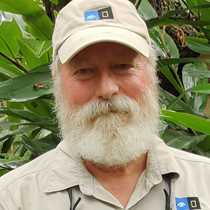Drygalski Fjord & Cooper Bay
First thing this morning, we were excited to see the rugged, snow-covered mountains of South Georgia looming directly ahead of us. We had arrived at the southeastern end of the island, which is composed of ancient sections of continental rock that are very similar to the mountains we saw at the Antarctic Peninsula. It is worth noting here that the geology of the northwestern end of the island is very similar to that found in Tierra del Fuego at the tip of South America. Geologists tell us that South Georgia was once a bridge between these two continents before it was dragged away to its present position by movements of the Scotia Plate.
The National Geographic Explorer entered the Drygalski Fjord right after breakfast and we cruised several miles inland through the narrow and dramatic waterway all the way up to the face of the very active glacier at its head. It was interesting to watch a large flock of Antarctic terns feeding near the outwash of meltwater streams at one side of the glacier. We also saw many other familiar birds, including gentoo and chinstrap penguins, sheathbills, giant petrels, kelp gulls, and blue-eyed shags in the fjord system.
Cold wind and snow kept most people inside and the Bridge proved to give the best vantage (see image, top L). The mountainsides in this fjord are very steep and seem to rise straight up out of the sea, but we were still amazed to find the water in front of the glacier was more than 700 feet deep!
Drygalski Fjord has been formed by glacial ice scour over many thousands of years working its way down through a weakened joint or fault line between two separate geological formations…to our right (northward) we could see very old continental rocks that were once part of the supercontinent of Gondwana and are dated to more than 200 million years in age, and to our left (southward) we looked at volcanic and metamorphic rocks that formed 140 to 180 million years ago. Unfortunately, the light dusting of recent snow made it difficult to discern the differences.
In the early afternoon, we explored around the eastern end of the island and sailed into Cooper Bay where we could see many chinstrap penguins on one beach, and a couple small groups of king penguins on a smaller, nearby beach, as well as lots of fur seals cavorting near the water’s edge. Strong winds, sleet, and a heavy swell helped us decide to return to Drygalski Fjord and explore the more protected waters within a tributary fjord known as Larsen Harbour with our Zodiacs.
Even with snowy conditions, we happily set off to see what we could find in this magnificent waterway named for Carl Larsen, captain of the Antarctic which explored South Georgia and was destroyed by ice in the Weddell Sea during the Swedish Antarctic Expedition of 1901-1903. Larsen survived that ordeal and came back here the following year to establish the first whaling station on the island at Grytviken, in Cumberland Bay. Whales were so common around these waters at that time that six other whaling stations were soon established in bays along the northern coast. We saw no whales today within the fjord system, but we did encounter other marine mammals, i.e. pinnipeds. Young fur seals played around our boats as we maneuvered about in the kelp beds, and a lone Weddell seal, which is quite rare in these waters, approached a couple boats to investigate us (see image, top L).




